
Ishmeet Singh, the winner of the “Voice of India” contest, passed away today after drowning in a hotel swimming pool in the Maldives. He was the only son of his parents, and was set to perform at an event in Maldives capital. Such a tragic story and such a great loss for the Punjabi community.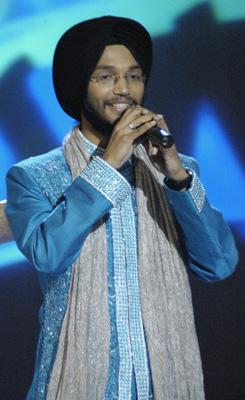 Ishmeet had been vocal about his intent to encourage Sikh youth to step out of the shadows and achieve their dreams.
Ishmeet had been vocal about his intent to encourage Sikh youth to step out of the shadows and achieve their dreams.
This talented Sikh turned out to be very humble, polite, and caring. His idea on winning rested in the ultimate sense to have faith in Waheguru wholeheartedly. He is an idol to many young Sikhs all around the world and he can inspire and motivate young Sikh men and women to succeed in life without compromising their values and traditions under any pressure whatsoever. While interviewing him, he very clearly said to me that in future he would do everything in his power to help Sikh youth with talent to step out of the shadow.
His Shabad Kirtan CD had just been released and many were hoping to see the beginning of a wonderful journey for Ishmeet. He will be greatly missed.
Previous Coverage of Ishmeet on the Langar Hall:
Some of you may have followed the case of Sarika Singh, a Welsh-Sikh student who was barred from school when the organization adopted a dress code that prohibited wearing jewelry, including religious items. Instead of conforming to the dress code or transferring schools, Singh appealed to the school. When officials refused to reverse their decision or provide exception for the kara (not an item of jewelry, but rather an article of faith), Singh sued under the UK’s anti-discrimination laws. She has been excluded from classes and from attending school for the past nine months.
Moments ago, the BBC reported that the UK’s High Court affirmed her case, stating that the dress code unfairly burdened Singh’s freedom of religious expression. Both advocates and the court expressed frustration with the school, stating that the issue had been clearly defined in U.K. statutes and case law for over 20 years. This judgment opens the door for students of all religious backgrounds; in addition to the banning of the kara, other UK (private) schools have moved to ban the crucifix, the hijab, and the yarmulke. Against this “confining” interpretation of secularism (an interpretation more common on the European continent), the UK courts have clarified the intent of the country’s inclusionary and anti-discriminatory legal framework.
We’ll continue to update with details and analysis as information becomes available.
A recent decision of the British Columbia Human Rights Tribunal highlights some complex clashes within the Sikh community. The B.C. Human Rights Tribunal dismissed a complaint by two members of the Canadian community who were denied membership in a Burnaby gurdwara because of their caste.
But it’s not what you think. The men who were refused membership did not belong to a caste that was historically disadvantaged, but instead, were jats. And the group who did the refusing were the historically discriminated-against Ravidassia.
Gurshinder Sahota and Sohan Shergill said they were discriminated against by the Shri Guru Ravidass Sabha Temple because they belong to a higher caste in the traditional system of social ranking than do temple members… The 900 members of the Shri Guru Ravidass Sabha Temple belong to the lowest group, Dalits, formerly referred to as “untouchables” and often considered outside the caste system altogether. Sahota and Shergill are from the jat caste, which is traditionally a land-owning class in the Punjab and now makes up much of Metro Vancouver’s Sikh community. [link]
Vancouver’s Ravidassia community celebrated the decision, affirming their right to protection from the greater Sikh community.
The decision, released this week, was hailed as an affirmation of temple members’ right to gather as a “minority within a minority,” said spokesman Jai Birdi. “Since the decision has come out, the members are feeling quite empowered by it,” he said. “They’re feeling that this really reinforces their ability to come together as a marginalized community from India to talk about their heritage and historical unresolved issues and come up with some strategies for moving forward.” He added that the complainants are welcome to attend the temple’s religious ceremonies and social programs. [link]
This post is just for fun. A week ago, a fellow langa-(w)riter asked which Singh was really King? As the buzz for the upcoming “Singh is Kinng” movie continues, many had heard the news that Snoop Dogg had donned a pagh for a promotion with Akshay Kumar.
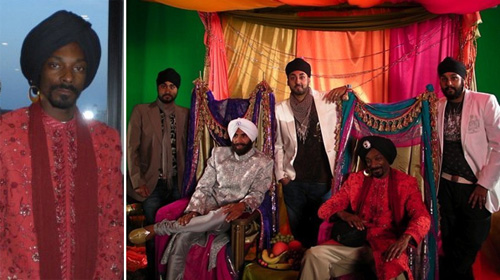 While many that were looking for Snoop Singh ended up finding this convert, my guess guess was that the people had something else in mind. Many people have emailed us asking if we had seen the picture of Snoop Dogg (for me he will always be Snoop Doggy Dogg) with the pagh. To make it easier for all of you internet hunters, here is the picture of Snoop with the turban, sitting like a king with Akshay.
While many that were looking for Snoop Singh ended up finding this convert, my guess guess was that the people had something else in mind. Many people have emailed us asking if we had seen the picture of Snoop Dogg (for me he will always be Snoop Doggy Dogg) with the pagh. To make it easier for all of you internet hunters, here is the picture of Snoop with the turban, sitting like a king with Akshay.
For a link explaining how Snoop came to don the turban in Chicago, you can read a link here.
Sources revealed that the rapper dressed exactly like a Sikh with a turban on his head while recording the track. They even said that the rapper was to have his own crew and clothes, but Akshay convinced him to wear a turban. [link]
This recent article about a granthi in Leeds suing for unfair dismissal brought me back to the topic of granthis in general. Given Sikhi’s very clear edict AGAINST the institution of a clergy, I always found it distressing to see whole gurdwaras managed and oragnized by hired granthis. If a sangat (or gurdwara) was too big to function on seva, hadn’t it possibly grown beyond its equilibrium? I always felt uneasy about high-profile (and high cost!) guest granthis, specialized sermons, and other performance-based methods in the gurdwara. Not to mention really distressed that lecturing and sermonizing often extended services and, in my opinion, often drew away from time spent in reflection around kirtan.
It also seems, to me, that the formal establishment (and acceptance) of granthis as “ordained” disciples of Sikhi encourages the creation of a laity. In theory, shouldn’t all Sikhs be capable of organizing and leading their own services? Shouldn’t we encourage everyone to achieve the literacy and familiarity necessary to comfortably participate in shabad kirtan, ardaas, and the basic requirements of langar? In the U.S., we absolutely do not provide sufficient resources to ensure this across sangats (some sangats are notable exceptions, e.g., the Beavercreek, OH, sangat, which is completely volunteer-run with no granthis, despite a population of <50 Sikhs). If we wanted to help mobilize Sikhs to be able to run their own gurdwaras, what kind of resources would we need to provide?
I understand that once we employ granthis there’s an implicit contract and deferral to their “wisdom,” but to what extent are we eroding our own personal understanding and potential for discussion, debate, and growth within Sikhi and within our own sangats? I have heard some liken granthis to spiritual guides; I would argue, however, that SGGS Ji is our guide, the Rehit Maryada our manual, and the sangat our laboratory for refining our understanding.
There’s been some controversy over the upcoming film, ‘Singh is Kinng,’ [sic] starring Akshay Kumar and a host of other Indian actors I don’t know, scheduled to hit theatres on August 8th.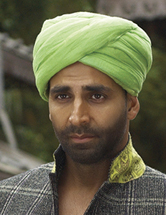
Singh is Kinng is a story about Happy Singh, a Punjabi Sikh. He is very mischievous and gets involved in a number of disastrous situations, so the villagers plan to send him to Australia to bring back his fellow villager, Lucky Singh. It is then revealed that Lucky is a underworld Don in Australia. Then, in a accident, Happy saves Lucky but still Lucky becomes paralysed. Hence, Happy becomes the new King of the Australian Underworld. [link]
For those who haven’t been following the controversy- the problem revolved around the portrayal of Sikhs in the movie (physical appearance as well as particular scenes). I haven’t seen much information on the scenes, but am assuming that they involve explicit conduct that was found offensive to screeners’ moral sensibilities. As for the the physical appearance, I can’t exactly blame critics after seeing what “Singhs” look like in the movie… (see picture on right). Um… I don’t know who tied his pag or what it’s made of or what type of fashion statement the movie is trying to make, but I don’t think any Singh I know would ever wear that.
For many Sikhs the name Sumedh Saini rings a solemn tone. Part of a handful of high police officials, Saini was the Superintendent of State Police in Chandigarh during the Troubles in Punjab. He reigned with fear, terror, and impunity.
 While the wheels of justice may be slow, the Central Bureau of Investigation (CBI), India’s premier investigating agency, has just released its indictment of Sumedh Saini. Saini has recently been indicted for abduction, illegal detention, and other offenses. While the charges pale against the thousands of ‘eliminations,’ for some they are taking solace for the CBI’s findings.
While the wheels of justice may be slow, the Central Bureau of Investigation (CBI), India’s premier investigating agency, has just released its indictment of Sumedh Saini. Saini has recently been indicted for abduction, illegal detention, and other offenses. While the charges pale against the thousands of ‘eliminations,’ for some they are taking solace for the CBI’s findings.
Total of four people were indicted by the CBI on Friday:
State Vigilance Bureau chief Saini, retired former Chandigarh DSP Baldev Singh Saini, Chandigarh SHO (Station House Officer) and ex-subinspector Harsahai Sharma and former subinspector now SHO Jagir Singh [link]
The findings are significant in face of his plum appointed position by Punjab Chief Minister, Parkash Badal, who had raised him to the head of the state’s Vigilance Bureau. While it will have little political traction, it points to the hypocrisy of the ‘banana republic’ that is the state of Punjab where the head of a bureau meant to guard against corruption is now being indicted for falsely arresting and torturing the state’s citizens.
Mr Saini is currently leading the Parkash Singh Badal government’s campaign targeting former chief minister Amarinder Singh and his associates. The CBI’s charges against him have come as certain embarrassment for the chief minister. [link]
It is still to be seen what will come from all this, will Saini actually be convicted and punished for his crimes? or will this just be another CBI indictment?
UPDATE: Although this post is over 5 months old, I thought I would give an update on the current case. It seems The Herald, a Catholic newspaper in Malaysia, has filed a lawsuit against the Malaysian government’s attempt to ban the usage of the word “Allah” by non-Muslims. The Malaysian Gurdwara Council (is this a real organization or a one-man show, can any of our Malaysian readers fill us in as I couldn’t find any information) has added their name to the lawsuit. Again, I revisit the question, can any one religous community claim a monopoly on its religious vocabulary? How about iconography?
———————————————————————————-
The Sikhs have a long, proud, and distinguished history in Malaysia. While Sikh traders began arriving in South East Asia, during the Mughal period, the Sikh numbers markedly increased under British imperialism.  Sikhs were often settled throughout the colonies as police men and later took a lead role in the transportation industry. Their presence and connection to Punjab has been strong throughout the past and the Khalsa Diwan Malaysia took an active role in ratifying and creating the Panthic Sikh Rehat Maryada during the early years of the 20th century. The Sikh Naujawan Sabha Malaysia remains a leading example of a diasporic Sikh organization.
Sikhs were often settled throughout the colonies as police men and later took a lead role in the transportation industry. Their presence and connection to Punjab has been strong throughout the past and the Khalsa Diwan Malaysia took an active role in ratifying and creating the Panthic Sikh Rehat Maryada during the early years of the 20th century. The Sikh Naujawan Sabha Malaysia remains a leading example of a diasporic Sikh organization.
Despite the Sikhs’ prominent standing in Malaysian society and the relatively secular nature of Malaysian Islam, it is of some note that the government recently moved to have the words “Allah” (God), “Kaabah” (Worship center at Mecca), and “Solat” (prayer) banned from non-Muslim literature and speech.
While I would guess Christian evangelism (Christians in Punjab love to call Jesus ‘Satguru’ and have ‘kirtans’ in his praise) was the main target of such legislation or appeasement towards certain political parties and groups, I am not sure what will be the impact for Sikhs due to our community’s unique lingual affinities with Islam.
Is it just me or are we seeing Giddha increasing in popularity these days?
Giddha was the folk dance of choice for our Grandmothers and Mothers. It allowed them a platform to get together with other women, and through boliyan talk openly about their daily lives. I asked my Mum if this was a form of therapy for them, and she said “yes”. It was a release for these women to be able to have this time for themselves and openly release supressed feelings in a joyful manner.
We see a great number of young women in Universities joining the “Bhangra” team and peforming these rather masculine dances at Bhangra competitions. Where is our traditional Giddha? I found this video which shows a performance by the UC Davis Giddha Squad at a competition this year. It was nice to see that these girls decided to create some uniqueness to the monotony these Bhangra competitions have began to display. Hopefully this will be a continuing trend and we will see more incorporations of Giddha for women at University levels. There is a sense of elegance and femininity that Giddha has, and which Bhangra lacks for women.
I look forward to the day when young girls are able to immerse themselves in Giddha and learn Boliyan and truly appreciate what our culture has to offer. Maybe we will see a Giddha Academy some day? I am hopeful.
With Teeyan season upon us, we can take the first step in going and attending these events in our areas. In the California we have these events scheduled annually and it’s become larger every year. Please make sure to attend if you know of Teeyan happening in your area. It would be a great way to take your Grandmothers, Mothers, Aunts, Sisters, Daughters, and Friends out to spend an afternoon together. (And it’s a great workout!)
How do you all feel about this subject? How can we begin to make a progressive change towards incorporating Giddha into the lives of younger women?
It was reported this week that a Court in Belgium has overturned a ban that had been established for five Sikh students wearing Patkas. This case began in May 2005, when these Sikh students were banned from attending KTA Domein Speelhof school in Belgium due to the implementation of a new uniform rule banning head coverings.
The court said that the ban on the religious head covering was a violation of the Sikh students’ right to manifest their religion under article 9 of the European Convention on Human Rights, of which Belgium is a signatory.
In a judgment handed down today, Judge Madam H. Coenen said that by excluding young people because of their religious beliefs the Domein Speelhof school in St Truiden had violated their right to practice their faith.
United Sikhs took up this case and are applauded for their great work.
The news comes at a time when our community is faced with many cases of injustice for practicing our faith as Sikhs. This is a positive step and shows that the fight for our rights as Sikhs is not a lost battle. It will take time, but we are progressing toward educating people who we are as a community. There are many more cases to be fought, but we will persevere.
REMINDER– If you’re in the New York area, take the morning off work/school on Monday and join the Sikh Coalition in a march to end harassment against Sikh students in public schools:
When: Monday, June 30th, 11:00AM
Where: Meet at Sikh Cultural Society: 95-30 118th Street or Gurdwara Baba Makhan Shah Labana: 113-01 101st Ave.
Why: 1) Sikh students have a right to attend school without fear of harassment for being Sikh, and 2) you can help future students have a better experience in school than you, your siblings, or your friends may have had!
————————————————————————————–
The violence against Sikhs in New York that the Sikh Coalition tracks, and reports is a representation/reflection of the violence that young Sikh students undergo in many areas of the US. In areas where we don’t hear about such violence, it’s not because it doesn’t occur, but because organizations like the Coalition don’t exist to track, report and respond to the violence.  Ideally, we should all be able to respond to the needs of our local community, and I hope that we are building the capacity to do so in the near future. In the New York area, the Coalition is responding.
Ideally, we should all be able to respond to the needs of our local community, and I hope that we are building the capacity to do so in the near future. In the New York area, the Coalition is responding.
In the latest of a spate of attacks on Sikh students in New York, 12 year old Gurprit Kaur had part of her braid cut off and thrown in the trash. This occurred about a little over a year after another student’s hair was forcibly cut in the New York area in May of 2007. In response to the series of attacks on Sikh students in the New York (especially Richmond Hill) area, in the face of inaction by authorities after the group’s troubling findings on harassment in the school system, the Coalition is organizing a march on Richmond Hill High School. [Click on flyer for details.]
SCORE has already come under scrutiny here in The Langar Hall, and I don’t wish to scrutinize the entire organization further. But their list of honorees from the 2008 Heritage Dinner does deserve some attention. This year, the following individuals were honored:
1. Sandeep Singh Caberwal, a Sikh entrepreneur in Silicon Valley and a model, wears a turban, has a beard and was chosen by designer Kenneth Cole in its recent fashion campaign
2. Ms. Tami Yeager and Preetmohan Singh for their film documentary “A Dream in Doubt,” which explores the real life story of Rana Singh Sodhi’s family, whose brother was murdered as the first hate crime victim in AZ in the 9/11 aftermath
3. Darshpreet Singh, a recent graduate of Trinity University in San Antonio, Texas. was co-captain of the Men’s Basketball team and fan favorite, and believed to be the only turbaned Sikh to play in a National college basketball game
4. Dr. Jagjit Singh Khalsa is the Chief of Medical Consequences of Drug Abuse at the US National Institutes of Health
5. Gurvendra Singh Suri, founder & CEO Optimal Solutions Integration, Inc., a successful technology consulting Company in Dallas, TX
6. Raghbir Singh Subhanpur, business owner from New York and President of New York Shiromani Akali Dal was honored with Community Service award
7. Surinder Singh Chawla, Nassau County Human Rights Commissioner, was honored for Social Activism and Service
8. Ro Khanna, an Indian American political activist from California was also honored for his role in supporting Sikh issues. [link]
Readers, what strikes you as odd about this list? . . . The only woman recognized is American. How is it possible that no Sikh women made any noteworthy contributions to the Sikh or American community in the past year? (There seems to be an attempt to recognize contributions to both Sikh and American, non-Sikh communities.) Let me tell you- it’s not.
The UK has been hit with a recent controversy over expenditures, allegedly upwards of £100,000, spent on finding appropriate anti-terror gear that could accommodate the Sikh turban. A good deal of this was spent taking the officer away from duty and asking him to approach equipment manufacturers himself to request accommodated gear. Shortly after this search period expired, he took a leave in order to cope with the emotional stress of this experience.
Two very salient arguments are made: One side argues that such cost was a “waste” and took the officer in training away from assignment (he was in limbo — he was not able to serve with the regular police, but without a uniform could not get full clearance to serve with anti-terror specialists). The other argues that the officer is sorely needed, that the county he hails from is actively trying to diversify its anti-terror police force, and that the cost is worth it if it paves the way for other ethnic and religious minorities to feel comfortable trying out to join the anti-terror squadron.
I think there’s validity to both arguments. Accommodation, especially in democracies, ought to be a key value in integrating diverse communities. That said, it sounds like the UK (or local) government did not take the issue of diversity seriously. The problem is not in the £100,000, per se, it’s in the failure of the state to actively support, or deal seriously with, the issue of Sikh guards.
But is there ever a (monetary) limit to accommodation? How do we find that limit? Is it a simple cost-benefit analysis, or are there other, more weighted, measures that come into play? Was it the money itself, or the poor management of said money?
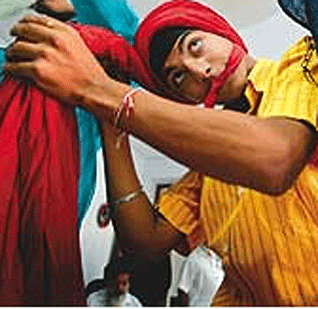 Could the community’s recent rallying in response to hate crimes have similar results (though in smaller proportions) as was seen after Operation Bluestar of people re-committing to their faith?
Could the community’s recent rallying in response to hate crimes have similar results (though in smaller proportions) as was seen after Operation Bluestar of people re-committing to their faith?
Many Sikhs today, unfortunately, cut their hair at some time during their adolescence. This is seen amongst Sikhs who are isolated in communities that have little or no exposure to Sikhs (or sometimes anything outside of that particular community) but also in communities with large numbers of Sikhs.
It seems that at least in New Jersey, the increasing number of Sikhs along with recent media exposure is alleviating at least one of the reasons that kids decide not to keep the Sikh roop.
Despite the recent brutal harassment of a high schooler in New Jersey which made international (Indian) news, some Sikhs in Jersey feel that awareness of Sikhs is growing. The media campaign after the incident has also probably contributed to increasing awareness in the area.
Apparently the police have arrested over 70 Sikhs in Mumbai for vandalizing MTV’s headquarters there. The reason for the protest and vandalism? Apparently MTV’s poster promos featured a sardarni massaging a man, which they found offensive to the faith community and its principles.
Now, I typically do not advocate vandalism or violence as a means of protest, but I think this incident brings up a larger issue around representation, especially for minority communities. Is it possible that there is a Sikh girl, somewhere, who is a masseuse? Probably. However, the issue at hand is whether or not such a representation is offensive to the teachings of Sikhi (I have not seen the poster, so I can’t comment on how salacious it is), and if so, what an appropriate response would be.
Like many other minority communities, Sikhs face a unique task in trying to combat stereotypical and lampooned representations in the media while dealing honestly with the diversity of experiences and viewpoints within the broader faith community. This event, while very different, reminded me of the gurdwara incident in the UK a few years ago. Many feel that it is dangerous to “indulge” negative representations because they tend to produce new stereotypes or to violate the ethic core of the community (a good example of stereotypical Sikh representations would be the buffoon/drunkard or villain/nemesis in Bollywood films). So, if this poster was offensive, how should the community have dealt with the issue? I don’t know if they had tried other tactics (e.g., letter writing, phone calls, non-violent protest), but then again, it’s not hard for a non-violent protest to turn to vandalism or other outward action.
In the U.S., SMART (now SALDEF) originally started as an organization to combat misleading and incorrect stereotypes in American media. The Mumbai case is different on many fundamental levels: Sikhs are a much larger and much more visible minority in India, there is less of an “excuse” for ignorance on the part of national media networks (or international, in this case). However, it doesn’t seem like there’s a great mechanism for dealing with incidences like this.
How can Sikhs work to balance negative representations against the reality of community issues without recasting themselves as another stereotype or caricature?
Revolutions come in strange shapes. Sometimes ‘French,’ sometimes ‘Islamic,’ other times ‘American,’ and maybe even ‘Russian.’ Closer to us, they may even be ‘Sikh.’ However, they may even be in the form of a carbohydrate.
During the 16th century, an expansionist Spain accidentally found itself in the ‘New(?) World.’ Armed with firearms, but mainly syphilis, the Conquistadors devastated a continent and saw the near annihilation of the native people. Along with the silver wealth brought back to Europe came the potato.
While the history of the potato is a famous story in its own right, the potentiality of the potato is becoming more impressive for a number of different policy makers. Recently the world stage is beginning to forecast a “food crisis” in the making. Those of us that keep an eye on Punjab and the rest of the world should begin paying more attention to the growing ‘food crisis.’ With an expanding world population and increasing consumption, some experts are predicting increasing global insecurity. An agrarian-sensitive Punjab would feel the repercussions of such insecurity manifold.
 72 year old Balwant (“Bobby“) Singh Grewal is walking 500 miles (800 km) from the Scottish Parliament Building in Edinburgh to the House of Parliament in London in five weeks. He began on June 5th and is scheduled to finish on July 9th. He is raising 100 million pounds for cancer research. (If you can’t tell by the bolded format, I’m rather impressed by this feat.)
72 year old Balwant (“Bobby“) Singh Grewal is walking 500 miles (800 km) from the Scottish Parliament Building in Edinburgh to the House of Parliament in London in five weeks. He began on June 5th and is scheduled to finish on July 9th. He is raising 100 million pounds for cancer research. (If you can’t tell by the bolded format, I’m rather impressed by this feat.)
Grewal is undertaking the walk to raise one million pounds for research into bowel cancer and other bowel diseases at St Mark’s Hospital, Harrow, a hospital unique in the U.K. [link]
This isn’t the first time Bobby Grewal has walked to raise large sums of money for medical research.
In 2001, he ran the London Marathon in just over five hours, and in 2004-5 (aged 68), he completed a walk covering 2,500 miles across India from the North-West frontier to the deep South…The walk raised 100,000 pounds for research into cancer and AIDS. [link]
Do you think Bobby Grewal is in the same class as the legendary Fauja Singh?
In a day of updates, I figured I should update this one as well.
Although losing out on the 100,000 pound grand prize, the dynamic duo of Suleman Mirza and Madhu Singh have been invited by Michael Jackson to join him on his comeback tour in the UK. The newspaper report is a bit ambiguous suggesting that Signature may also perform with MJ in Las Vegas as well. Amazing job fellas! I am sure they are on cloud 9.
—————————————————————
We’ve been following Signature over the last few months. From their audition appearance, to their semi-final Thriller, to even an interview with me highlighting their place in British Bhangra, before we all suffer from Signature overkill here is Suleman Mirza (often misspelled as Suleiman ) and Madhu Singh’s final performance.
Our dynamic Muslim and Sikh duo finished second on Britain’s Got Talent (BGT) to the dancing talent of George Sampson. While I was hoping for a “Beat It” performance, Madhu’s busy work schedule at PC World may not have allowed him to come up with a new routine. They stuck to their bread and butter of Tigerstyle’s Nachna Onda Nahin. A fine performance fellas. You even got Simon Cowell and the rest of the dorky judges to dance in their chairs.

In Ceres, California an 86 year old Sikh bibiji, Jagir Kaur Johal, was found stabbed to death in her home. The Modesto Bee reports:
She died as a result of loss of blood from a stab wound to the chest and multiple slash wounds to the face, arms and legs, the Stanislaus County coroner’s office said.
Authorities said today the woman’s husband, 85-year-old Piara Johal, likely will be arrested.
Johal had a knife wound on his hand. The man was “suffering from some kind of confusion. He’s not sure what happened,” McKay said. “He acted as if he didn’t know of her injuries.”
“This is a hard case,” McKay said. “He’s old. He’s feeble. We don’t even know he if knows what he did — if he did it.” [link]
WARNING: This is MY opinion and DOES NOT not represent anyone else on The Langar Hall. Hopefully, unlike Ennis, I won’t have to take this one down.
I am sure I am going to be labeled as a hater. I don’t care it must be said.
Scouring the news I came across a recent press release by the Sikh Council on Religion and Education. I almost feel even more embarrassed by highlighting it. SCORE, for the uninitiated, is a Sikh organization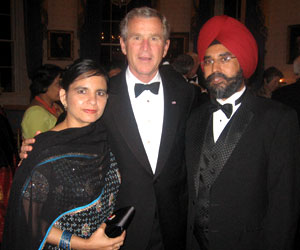 based out of Washington DC. It is the child of Dr. Rajwant Singh, a Maryland-based dentist. He is definitely one of those guys that likes to ‘speak for Sikhs.’
based out of Washington DC. It is the child of Dr. Rajwant Singh, a Maryland-based dentist. He is definitely one of those guys that likes to ‘speak for Sikhs.’
Like many Sikh organizations, SCORE is a one-man show. Don’t believe me, check out the pictures on the website, you’ll find few without Dr. Rajwant Singh. He may be the most pictured Sikh-American. (Look to the right, I just added one more!)
Now I really don’t know what SCORE does, other than look for photo opportunities, but to Dr. Rajwant Singh’s credit, he has established relationships with many political figures in Washington DC and has ingratiated himself as the ‘Sikh’ representative in many interfaith functions and communities in DC. DC loves interfaith functions! That is a good thing. Sikhs should have a representative and in the meantime we have Dr. Rajwant Singh.
